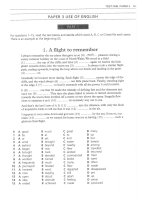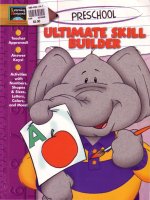preschool ultimate skill builder
Bạn đang xem bản rút gọn của tài liệu. Xem và tải ngay bản đầy đủ của tài liệu tại đây (13.07 MB, 324 trang )
096.436.17
4
•
7
\\\~\~\\\~l\~~\~
,,09
353958
The Ultimate
Wa
and Learning
conY,.td
o
Build
Skills
I
ence!
Dear
Parent.
Mastering
any
kind
of
learning,
whether
it's
math
or
language,
takes
practice.
And
the
more
regular
the
practice,
the
more
quickly
a child
usually
progresses.
This
Skill
Builder
workbook
covers
a
range
of topics
normally
presented
during
the
school
year.
The
activities emphasize
the
key
building
blocks
for
academic
success.
Is
this
book
appropriate
for
my
child?
If
you
work
with
your
child
at
home
and
regularly
speak
with
his
or
her
teacher.
you're
aware
of
strengths
and
weaknesses
in
various
learning
areas
and
probably
have
a
good
idea
of
exactly
where
your
child
needs
help.
The
skill
notes
at
the
bottom of
each
page
will
help
you
locate
pages
that provide practice
on
particular topics.
How
can
this
book
help
my
child?
It
can
provide
more
practice
on
skills
already
introduced
in
school,
and
it
can
be
used
to
review
material
necessary
for
mastery
of
the
subject.
If
the
book
is
used
in
either
of
these
ways,
the
child
may
need
a little
help
on
some
pages
but
should
be
able
to
complete
most
without assistance.
The
book
can
also
be
used
to
introduce
new
skills.
If
you
use
the
book
in
this
way,
you
may
need
to
take
time
to
help
your
child understand
the
new
information.
Remember
that
your
encouragement
and
support
will
go
a
long
way
toward
ensuring
success.
HoW
can
1 foster
successful
practice
sessions?
~
Set
aside
a quiet,
comfortable
work
area.
~
Provide
necessary
materials,
such
as
sharp
pencils.
erasers,
crayons,
and
scissors.
~
Keep
work
times
short.
frequent.
and
fun!
Do
nO
more
than
1 or 2
pages
per
session.
~
Review
completed
pages
as
soon
as
possible
after
the
child
has
finished
them.
Praise
success.
But
if
errors
have
been
made,
offer
help
in
a positive
way.
Remember:
Making
mistakes
is
a
part
of
learning!
Congratulations
on
choosing
to
take
this important step
in
fostering
your
child's
learning
success!
Sincerely,
Your
Friends
at
Learning
Horizons
© 2003 Learnl H
One
_American
~
onzons,
Inc
Fabnque pour
Load:
Cleveland.
OH
4414 .
One
Ameri~~
Reaming HOrizons
Inr
4.
Pnnted
In
USA
Visit
us
at·
.
www.learningho
.
rlzons.(Om
""n
oad
CI
,,,
No
part of
thiS
book'
eveland,
OH
44144. F
any retrieval syste may be reproduced
in
a
a~rique
en USA.
m Without the written p
ny.arm
or stored
in
erml$$IOn
of
the publisher
Table
of
Contents
Numbers I
2
-"ese
pages help the child learn
and
recognize numbers 1-5. They include practice activities for tracing
and
riting numerals, counting, matching numerals with the correct number of objects, understanding numerical
~rder,
ond identifying "more"
and
"Iess."
Numbers II
32
-his section helps the child learn
and
recognize numbers 6-10. Activities include tracing
and
writing numerals,
counting,
matching numerals with the correct number of objects,
and
understanding numerical order.
Shapes
and
Sizes
62
Continue to build the child's early math
skills
with this section, which includes activities for identifying
and
tracing basic shapes
as
well
as
an
introduction to sizes
and
size words.
Letters I
92
These pages help the child learn
and
recognize letters Aa-Oo. Practice activities focus on matching capital
and
lowercose letter partners
and
tracing
and
writing letters.
Letters II . . . . . . . . . . . . . . . . . . . . . . . . . . . . . . . . . . . . . . . . . . . . . . . . . . . . . . . . . . . . . . . . . .
128
With these pages, the child learns
and
recognizes letters Pp-Zz by matching capital
and
lowercase letter
partners
and
tracing
and
writing letters.
Beginning Letter Sounds . . . . . . . . . . . . . . . . . . . . . . . . . . . . . . . . . . . . . . . . . . . . . . . . . . .
164
This
section introduces
and
teaches sounds
for
consonants
and
vowels
at
the beginning of words.
Get
Ready to Read
197
These pages help
prepare
the child for reading with activities that include recognizing differences
in
direction,
classifying objects, ond identifying objects that
go
together.
Get
Ready to
Write
229
In
this section, the child practices tracing lines to complete pictures, tracing letters,
and
solving mazes.
These
skills
are
necessary for a child who
is
learning how to write.
Colors
257
A variety of activities help the child identify colors
and
color words
in
this section. The child
is
also introduced
to names for
people, places,
and
things,
as
well
as
opposites.
Beginning Reading
289
These pages include practice for early reading
skills.
The activities
are
geared
toward recognizing sight words,
drawing conclusions,
and
making predictions.
Point to
and
say the numeral.
Ask
the child ta count
and
color the bird
at
the top of the page.
Then
ask
him
or her to
count
and
circle one bird
at
the bottom.
Counting 1
Count and color 1.
Count and
circle
1.
2
Understanding numbers: identifying a set
of
one
'5l<
the
child
to
count and color one
item
in each group.
Showing 1
Count and color 1
in
each group.
Understanding numbers: identifying a
set
of
one
3
Point
to
and
say the numeral.
Ask
the child to count
and
color the gingerbread houses
at
the top of the page.
Then
ask
him
or
her
to
count
and
circle two gingerbread men
at
the bottom.
Counting 2
Count and color
2.
Count and circle
2.
4
Understanding numbers: identifying a set of two
-,
the
child to count and calor two items in each group.
Showing 2
:ount and color 2
in
each group.
Understanding numbers: identifying a
set
of
two
5
Point
10
ond
say the numeral. Ask the child to count
and
color the shells
at
the lop of the page. Then ask
him
or
her to
count
and
circle three shells
at
the bottom.
Counting 3
Count and color
3.
Count and
circle
3.
6
Understanding numbers: identifying a set of three
""sk
the
child
to count ond color three
items
in
each group.
Showing 3
Count
and color 3
in
each group.
Understanding numbers: identifying a set
of
three
7
Ask
the child to count the number of downs
in
eoch group.
Then
have
him
or her draw a line
to
the number that shows
how many there are.
Circus Fun
Draw
a line
to
the
correct number.
8
Understanding numbers; matching groups of objects
and
numerals
1-3
.",
'"'>e
child to count the number
of
instruments in each group.
Then
have him
or
her circle the number that
shows
how
-_J"'o
!+'!ere
are.
Music
Fun
Circle the correct number.
I
2 3 2
2
3 3 I
Understanding numbers; matching groups
of
objects and numerals
1-3
9
Point to
and
say the numeral.
Ask
the child to count
and
color the bears
at
the top of the page.
Then
ask
him
or her to
count
and
circle four dolls
at
the bottom.
Counting 4
Count and color 4.
Count and circle 4.
10
Understanding numbers: identifying a set of four
,
,., child
to
count and color four
items
in
each group.
Showing 4
Count and color 4
in
each group .
•
•
\
Understanding numbers: identifying a
set
of
four
II
Point to
and
soy the numeral.
Ask
the child
to
count
and
color the easels
at
the top of the page. Then ask
him
or
her to
count
and
circle
five
paint trays at the bottom.
Counting 5
Count and color
5.
Count and circle
5.
12
Understanding numbers: identifying a set of
five
~
~
child
10
count and color five
items
in
each group.
Showing 5
Count and color 5
in
each group.
Understanding numbers: identifying a
set
of
five
13
.1'1
Ask the child to count the number
of
animals in each box.
Then
have him
or
her
draw
a line between the groups with
the same number.
On
the
Farm
Match.
14
Understanding numbers; matching
sets
of
1-5
~~
~~v
~~
~,.
the
child to read the numeral
at
the beginning
of
each row.
Then
have him
or
her color that number
of
animals
.
~e
row.
At the
Zoo
Color the correct number.
Counting to
5;
matching numerals with the correct number
of
obiects
15
Ask
the
child to count
the
fish
in
eoch group.
Then
have him
or
her
draw
a line to
the
matching numeral on
the
right.
Gone Fishing
Match.
16
Counting to
5;
matching numerals with
the
correct number
of
objects
Ask
the
child to count
the
number
of
seo
creatures
in
each group.
Then
have him
or
her circle
the
number that
shows
how many there are.
Under
the Sea
Circle the correct number.
2
1.1
I 3
2
I
3
5
3
2
Counting to
5;
matching groups
of
objects and numerols
5
I
17
Ask
the
child
to count
the
number
of
objects
in
each group.
Then
have
him
or
her
circle
the
group
with
more
in
each
row.
More
Circle
the
group with more.
18
Understanding
more
and
less
·
Ask
the
child
10
count
the
number
of
objects
in
eoch group.
Then
have
him
or her
circle
the
group
with
less
in
eoch
row.
Less
f
-
Circle
the
group
with
less.
Understanding
more
and
less
19
Ask the child
to
rood the numeral on ooch tree trunk.
Then
have him
or
her
draw
that number
of
apples on
the
trees.
Apple Trees
Draw
d s on the 9
20
Counting to
5;
recognizing numerals;
drawing
to
show numbers
2
5
•
Ask
the child to count
and
color the picnic baskets, cats, clouds, ants,
and
trees
in
the picture.
Then
have
him
or
her
circle the number that he
or
she counted for each.
The Cats' Picnic
Count and color. Circle how many.
~
I
2
[2)
3
4
2
3
{i
3
4
~
4
5
Counting to
5;
recognizing numerals
21
Ask the child
to
predict
what
the picture
will
shaw when completed. Then have
him
or
her connect the dots
in
numerical
order
and
color the picture.
High
Wire
Dot-to-Dot
Connect the dots from 1 to 5 .
•
0
2
o
o
o
o
•
4
•
5
22
Understanding numerical order; developing fine motor control
-
Ask
the
child to predict whot
the
picture will show when completed.
Then
hove him
or
her connect
the
dots
in
numerical
order and color
the
picture.
Raccoon Dot-to-Dot
Connect the dots from 1
to
5.
2
•
•
3
•
4
Understonding numerical order; developing fine motor control
23









